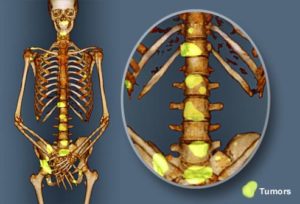A total of 151 patients were included in this study (mean age 60.4 years, 57.6% males). The 5 most common metastatic tumor types were lung, multiple myeloma, renal, breast, and prostate cancer. The majority of patients had radioresistant tumors (82.7%) and had an active primary site at presentation (67.5%). The median time from tumor diagnosis to cord compression was 12 months and the median time from identification of cord compression to death was 4 months.
Preoperative presenting symptoms included motor weakness (70.8%), pain (70.1%), sensory disturbances (47.6%), and bowel or bladder disturbance (31.1%)…
At follow-up, 58.3% of patients had improved status, 31.5% had no improvement, and 10.0% had worsening of functional status.
The mean QALY gained per year in the entire cohort was 0.55. The mean QALY gained in the first 6 months was 0.1 and in the first year was 0.4. For patients who lived 1-2, 2-3, 3-4, or 4-5 years, the mean QALY gained were 0.8, 1.4, 1.7, and 2.3, respectively.
Preoperative motor weakness, bowel dysfunction, bladder dysfunction, and ASA (American Society of Anesthesiologists) class were identified as independent predictors inversely associated with good outcome.
The mean QALY gained from surgical decompression in the first 6 months and first year equals 1.2 months and 5 months of life in perfect health, respectively. These findings suggest that surgery might also be beneficial to patients with life expectancy < 6 months.
Evaluating Treatment Strategies for Spinal Lesions in Multiple Myeloma: A Review of the Literature
“Background: Vertebral disease is a major cause of morbidity in 70% of patients diagnosed with multiple myeloma (MM). Associated osteolytic lesions and vertebral fractures are well documented in causing debilitating pain, functional restrictions, spinal deformity, and cord compression. Currently, treatment modalities for refractory MM spinal pain include systemic therapy, radiotherapy, cementoplasty (vertebroplasty/kyphoplasty), and radio frequency ablation.
Our objectives were to report on the efficacy of existing treatments for MM patients with refractory spinal pain, to determine if a standardized treatment algorithm has been described, and to set the foundation upon which future prospective studies can be designed…
Conclusions: Treatment options—radiotherapy and/or cementoplasty—for vertebral lesions and pathologic fractures in MM patients demonstrate significant radiographic and clinical improvement. However, there is no consensus in the literature as to the optimal treatment modality as a result of a limited number of studies reporting head-to-head comparisons.
One study did find significantly improved pain and functional scores with preserved vertebral height in favor of kyphoplasty over radiotherapy. When not contraindicated, we advocate for some form of cementoplasty. Further prospective studies are required before implementation of a standardized treatment protocol.
Kyphoplasty for patients with multiple myeloma is a safe surgical procedure: results from a large patient cohort.
INTRODUCTION: Only in recent years has balloon kyphoplasty gained significance in the treatment of vertebral fractures as an adequate minimally invasive vertebral stabilization technique. Kyphoplasty has also increasingly been used to treat vertebral osteolyses caused by multiple myeloma (MM).
PATIENTS AND METHODS: In our cohort of 76 patients with MM with a total of 190 vertebral fractures treated with kyphoplasty, we performed a 30-day postoperative analysis of cement leakage, neurologic symptoms, pulmonary embolism, and infections.
RESULTS: Painful osteolytic or fractured vertebrae or even imminent vertebral instability caused by osteolyses were seen as indications for kyphoplasty. One case of pulmonary embolism was observed because of cement leakage as the only postoperative complication.
CONCLUSION: By careful interdisciplinary indication setting and a standardized treatment model, kyphoplasty presents a very safe and effective procedure for the treatment of vertebral osteolyses and fractures caused by MM.





